Home / Organic Chemistry IUPAC Nomenclature Demystified With A Simple Puzzle Piece Approach
Alkanes and Nomenclature
Organic Chemistry IUPAC Nomenclature Demystified With A Simple Puzzle Piece Approach
Last updated: January 11th, 2023 |
IUPAC Nomenclature Demystified with a Simple Puzzle-Piece Approach, by Leah Fisch
 Note from James: This is a guest post by Leah Fisch of Leah4Sci.com , an online resource for learning organic chemistry, MCAT preparation, and other science topics . This is an epic, comprehensive post on organic chemistry IUPAC nomenclature. You might want to bookmark this page for future reference, and be sure to visit Leah’s Youtube Channel for more videos on nomenclature as well as other organic chemistry topics. Leah also tutors MCAT and organic chemistry. Her tutoring page is here.
Note from James: This is a guest post by Leah Fisch of Leah4Sci.com , an online resource for learning organic chemistry, MCAT preparation, and other science topics . This is an epic, comprehensive post on organic chemistry IUPAC nomenclature. You might want to bookmark this page for future reference, and be sure to visit Leah’s Youtube Channel for more videos on nomenclature as well as other organic chemistry topics. Leah also tutors MCAT and organic chemistry. Her tutoring page is here.
Table of Contents
- Why Nomenclature Is So Important For Organic Chemistry Students
- The Puzzle Piece Approach To Naming Organic Compounds
- A Word About Line (Skeletal) Structure Before We Begin Naming
- Highlighter Trick For Identifying The Parent Chain
- Parent Chain Length = The Molecule’s First Name
- Ane, Ene, Yne = The Molecule’s Last Name
- Numbering The Pi Bonds
- Substituents Arise When The Highlighter Trick Fails On The Branches
- If It Sticks Out, It’s A Substituent
- How To Indicate Multiple Substituents
- Alphabetize Multiple Substituent Types
- Separating Numbers and Letters
- Substituents WITH Substituents – What Happens?
- ‘R’ Is The Rest of The Molecule
- Functional Groups As The Molecule’s Last Name
- Putting Together The Pieces: A Practice Example
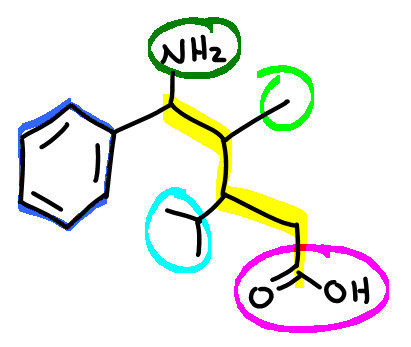
1. Why nomenclature is so important for organic chemistry students
As an organic chemistry student, organic chemistry IUPAC nomenclature will be one of the first topics you encounter. But just because it comes first, doesn’t mean that you can simply tackle it and move on. Learning how to name organic compounds is the foundation upon which your entire organic chemistry knowledge will be based.
Much of organic chemistry is about reactions, mechanisms and products. But you will be asked about nomenclature every step of the way.
- Name the product of this reaction
- React ‘molecule name’ with ‘other molecule name’
- Draw a complex multiple-functional-group product
Knowing how important your naming skills are to this course, you need to come up with a simple yet logical approach to naming even the most complex organic compound while taking into account all the different molecular prefixes, chain types, substituents, functional groups and more.
2. The Puzzle Piece Approach to Naming Organic Compounds
If I told you that I met a woman with a 4-part name and asked YOU to put the parts in order, I bet you’d get it on the first attempt.
Try it
- Jane
- Jr
- Doe
- Miss
Does your attempt look like this: Miss Jane Doe Jr ?
How did you get it right on the first shot?
I’m guessing it’s because you have an inherent understanding of the human naming system.
We all have a first and last name.
Some people have a prefix such as Miss, Doctor or Sir.
And some people have a suffix such as Jr, Sr, or III
Miss Jane Doe Jr breaks down as follows:
- Prefix = Miss
- First Name = Jane
- Last Name = Doe
- Suffix = Jr
Organic Compounds Follow a Similar Naming Pattern
- Prefix = substituent
- First Name = carbon chain number
- Last Name = type of chain
- Suffix = highest priority functional group
And so your simple approach is as follows: When you come across a complex molecule with multiple components to name, identify each one individually. Put its name on a list then view the list items as a puzzle that must be put together in a logical sequence.
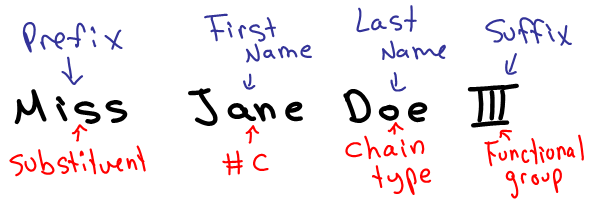
3. A Word About Line (Skeletal) Structure Before We Begin Naming
When learning and practicing nomenclature you will find yourself drawing molecules over and over again. While Lewis structure may appear easier to read at first, you may put your sanity at risk having to draw out hundreds of C, H, and O atoms.
Instead, I recommend that you get used to drawing in line structure – also called skeletal structure or bond-line notation. This method is both faster to draw and easier to read. This entire tutorial will be illustrated in line structure. If you are not yet familiar with this method then I urge you to study the short video below.
4. The Highlighter Trick for Identifying the Parent Chain
Let’s refer back to Miss Jane Doe Jr. While she has four parts to her name, you can easily get away with just referring to her as Jane Doe. This is her ‘core’ name or her ‘parent name’.
The core skeleton of an organic compound is called its parent chain. This refers to the simple skeleton or backbone of the molecule, upon which all the functional groups and substituents are attached.
This is the first component to name and identify.

The parent chain is the longest continuing carbon chain in a molecule (there are some exceptions). Sometimes the parent chain will be written in a simple manner and sometimes the chain will wind and twist.
But as long as the carbons are connected, one to the next, to the next, this is considered the parent chain.
The highlighter trick is a trick to help you determine if a chain is continuous or not.
Place your highlighter at the very start of the molecule. Without lifting the highlighter, trace over every connected carbon. If you have to lift the highlighter to reach another carbon, then it’s not part of the parent chain.
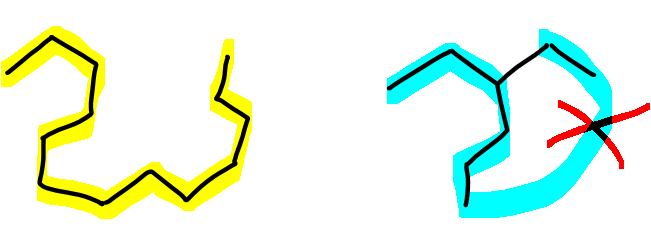
5. Parent Chain Length – The Molecule’s First Name
Count the number of carbon atoms after identifying and highlighting your parent chain. I recommending actually numbering your molecule. This is a good habit to develop NOW as it will provide a reference point later on when you have to name multiple substituents and functional groups.
You will assign a first name to your molecule based on the number of carbons present in the parent chain as follows:
- meth
- eth
- prop
- but
- pent
- hex
- hept
- oct
- non
- dec
You will definitely be required to memorize 1-10 above. Some professors may require you to memorize first names for carbons 11-20 as follows: - undec
- dodec
- tridec
- tetradec
- pentadec
- hexadec
- heptadec
- octadec
- nonadec
- icosa
6. Ane, Ene, or Yne – The Molecule’s Last Name
Now that you have a first name, you need a last name too. The last name comes from the saturation of the parent chain, specifically the presence and location of double and triple bonds.
These molecules fall into 3 categories:
- Alkane
- Alkene
- Alkyne
An alkane is a saturated molecule which does not contain any double (pi) bonds.
An alkane has a last name of ‘ane‘
An Alkene is partially unsaturated and contains a least one double or pi bonds.
An alkene has a last name of ‘ene‘
An Alkyne is the most unsaturated and contains a triple bond. This is 2 pi or double bonds between the same 2 carbon atoms.
An alkyne has the last name of ‘yne‘
(This method applies to the standard orgo 1 / orgo 2 curriculum containing mostly hydrocarbons and alkyl halides)

7. Numbering the Pi Ponds
When numbering a molecule with just Pi bonds, your goal is 2-fold:
- Number the chain so that you have a total lowest set of numbers.
- Designate the pi bond number as the lower of the 2 numbers to hit the pi bond.
Let’s apply these rules by naming the 3 compounds pictured below:

Molecule A:
This molecule does not contain any pi bonds. We can number from the right or left for a total of 5 carbons.
- 5 carbons in the parent chain for a first name of pent
- fully saturated (no pi) for a last name of ane
Molecule A is named pentane.
Molecule B:
Molecule B contains a single pi bond in the middle of the chain. We have the option of numbering from the right or the left given that the pi bond will be between carbon 3 or 4 from both directions. I’ve designated this in red and blue to help you see this clearly
In both scenarios the pi bond occurs between C3 and C4. The pi bond is numbered as ‘3-ene’ given that carbon 3 is the lower of the two numbers containing the double bond.
- Six carbons in the parent chain for a first name of hex
- Pi bond on carbon 3 for a last name of 3-ene
There are two ways to put this name together. Most professors will accept both. Ask your professor which method is preferred to ensure that you don’t lose any quiz/exam points.
Molecule B = hex-3-ene or 3-hexene
Notice that for the second version I pulled the number 3 to the front of the molecule. I like this method since it sounds nicer and flows better.
Molecule C:
Molecule C is a terminal alkyne meaning it has a triple bond at the very start of the molecule. Since the alkyne does not have any substituents, the end of the chain with the alkyne becomes number 1.
- Four carbons in the parent chain for a first name of but
(Counting alkyne carbons can be tricky, I’ve added red dots to help you identify the 4 carbons) - Alkyne on the first carbon for a last name of 1-yne
Putting the name together Molecule C = but-1-yne or 1-butyne

8. Substituents Arise When the Highlighter Trick Fails on the Branches
If only nomenclature ended as above with just a first and last name. But alas, simple doesn’t really exist in organic chemistry. So let’s build on this foundation and add puzzle piece components to our so far logical approach.
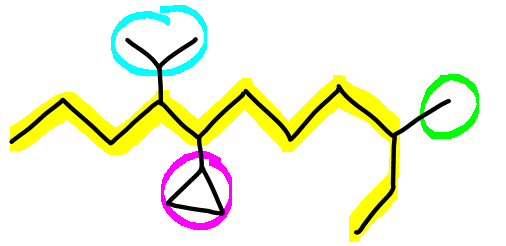
After highlighting your parent chain, you may find yourself staring at a carbon or two that is not yet colored. If you have to lift your highlighter to color these atoms, then they are not part of your parent chain.
9. If it Sticks Out – It’s a Substituent
These atoms or groups of atoms are considered your substituents, and represent the prefix ‘Miss‘ for Miss Jane Doe. The most common simple substituents include halogens and short carbon chains.
To Name a Halogen Substituent
To name a halogen substituent such as F, Cl, Br, I – drop the ending of the halogen name, and replace with ‘ide’.
Thus halogen substituents are named as follows:
- F = fluoride
- Cl = chloride
- Br = bromide
- I = iodide
Full name: 2-bromo pentane
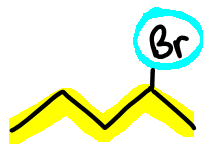
Naming Simple Alkyl Substituents
Simple carbon branches are named similar to carbon parent chains.
- Count the carbon atoms and apply the same designation used above
- Use the ending ‘yl’ to imply that this is a substituent
For example, a 2-carbon substituent is named as follows:
2 carbons = eth
substituent ending = yl
Substituent name = ethyl
Full name: 3-ethyl pentane
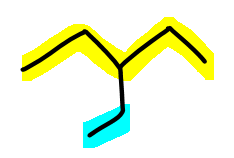
10. Indicating Multiple Substituents
When more than one of the same substituent occurs, you have to use a new prefix to designate how many are present as follows:
- no prefix needed, self understood
- di
- tri
- tetra
- penta
(You will likely encounter a max of five identical substituents in organic chemistry)
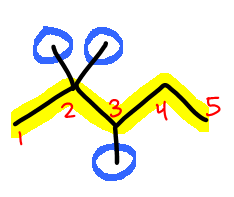
11. Alphabetize Multiple Substituent Types
Panic usually sets in when multiple types of substituents occur on the same molecule.
Don’t panic!
And certainly don’t try to name the entire compound in one shot.
Instead, write out your puzzle pieces one at a time. In my Organic Chemistry IUPAC Naming videos you will notice that I mark off every component as I address it, by highlighting chains or circling substituents.

Let’s apply this approach to a simple multi-substituted compound pictured here. Then follow the puzzle piece approach as follows:
- Highlight the parent chain
- Number from the left for a total lowest set of numbers
- Make a list on the side of the molecule with all your puzzle piece components (see image below)
- eight carbons in parent chain for a first name of oct
- double bond on second carbon for a last name of 2-ene
- 2 single-carbon substituents on C2 and C4 for 2,4-dimethyl
- 2-carbon substituent on carbon 5 for a prefix of 5-ethyl
Note on 2,4-dimethyl
Notice that there are two indications of the fact that there are two methyl groups present:
‘di’ indicates that there are 2 groups.
2,4 indicates the carbon atom where each methyl group occurs.
Now that we have a simple list of substituents – let’s put it all together. We have no functional group (last name) and so we follow the pattern of
prefix – first name – last name
But we have a problem. There are two sets (not one) of substituents present.
When faced with more than one type of substituent, order them alphabetically.
While it appears that dimethyl should precede ethyl, (d before e) it’s actually the other way around.
The ‘di’ in dimethyl is an adjective and is not counted for alphabetical order.
Instead we look at the ‘m’ in methyl and ‘e’ in ethyl. Since ‘e’ comes before ‘m’ ethyl comes before dimethyl.
This also applies ‘tri’, ‘tetra’, etc.
The prefix ‘iso’ is an exception to this rule and will count as ‘i’ when considering alphabetical order.
Remember that with pi bonds you have the option of pulling the pi-bond number before the parent or first name.
This gives us two correct answers:
- 5-ethyl-2,4-dimethyloct-2-ene
- 5-ethyl-2,4-dimethyl-2-octene
I personally think the second version flows better but be sure to find out which version YOUR professor prefers.
12. Separating Numbers And Letters
Two more quick rules on the above:
- Use commas between two numbers.
- Use dashes between a number and letter regardless of which comes first.
13. But What Happens When a Substituent Has Its Own Substituent?
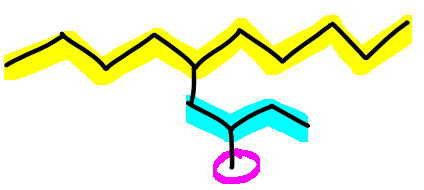
Now that you’re comfortable naming substituents, how do you name a molecule that has a substituent ON ITS SUBSTITUENT?
In other words, how do you name a branched branch?
The bad news: this process is tedious.
The good news: There is an acceptable shortcut.
You are more likely to be tested on the acceptable shortcut and so I won’t go into the tedious method here. However you can catch the complete explanation and correlation on my branched chain substituent video below:
Who Doesn’t Love a Shortcut?
There are 4 very common branched substituents that you will see again and again in your organic chemistry course. Since these branches are isomers of straight-chain substituents, they will be named as an isomer of the substituent they represent.
14. ‘R’ is the Rest of the Molecule
When you see ‘R’ anywhere on your molecule, recognize that this represents the Rest of the molecule. However, to keep things simple, and given that we are not looking at that portion of the molecule, just cut it all out and draw ‘R’ in it’s place. For the purpose of branched substituents, ‘R’ will represent the invisible parent chain.
Methyl and ethyl substituents are short substituents and can have no branched isomers.

A propyl substituent has a single isomer as pictured.
Propyl is a 3-carbon substituent. When connected in sequence (in a line) we simply call it propyl, however, when connected to the parent chain by the second instead of the first carbon, it gets the name ‘isopropyl’.
Iso is a group that you will see again later so recognize that an ‘iso-tail‘ is like a mermaid’s tail or fork in the road.

A butyl substituent has four carbons in a row. With more carbons we get more isomer opportunities, in fact, butyl has a total of four isomers as follows:
- Butyl has all four carbons in a row, attached to the parent by the first carbon.
- Secbutyl or 1-methylpropyl all four carbons still in a row, but secbutyl is attached to the parent by the ‘second’ or secondary carbon
- Isobutyl or 2-methylpropyl has a forked or ‘iso-tail’ on a 3-carbon substituent chain.
- Tertbutyl or 1,1-dimethylethyl is unique in that it has 2 methyl branches coming off the first carbon in a 2-carbon chain.
15. Functional Groups As The Molecule’s Last Name
And finally we have our last name. Functional groups come in many forms, from the alcohol OH groups to the carboxyl CO2H. When faced with a single functional group it becomes the last name of the molecule. When faced with more than one functional group you simply choose the group with the highest priority as the last night.
Visit This Table Of Functional Group Priorities for a quick review on functional group priority and appropriate last names.
16. Putting It All Together: A Practice Example
But let’s try a quick example. Here we have a 5-carbon chain with a CH3 functional group and CHO at the end.
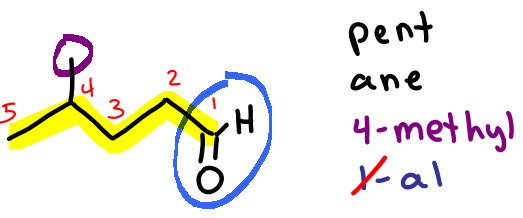
We break this down as follows:
- 5 carbons in the parent chain for a first name of pent
- Only single bonds for a last name of ‘ane’
- Functional group on the right so we start numbering at the CHO
- CH3 on carbon-4 for a prefix of ‘4-methyl’
- Aldehyde on the first carbon for a last name of ‘al’
Note that terminal functional groups such as carboxylic acid, aldehydes and more are implied to be on the first carbon and thus requires no numerical designation.
In putting the name together we follow the format of prefix -first name – last name – suffix
One final adjustment. Since ‘al’ starts with a vowel and ‘ane’ ends in a vowel, we drop the ‘e’ in ‘ane’ allowing the name to flow better for a final name of 4-methylpentanal
For even more organic chemistry IUPAC nomenclature tutorials, visit my website Leah4sci.com/naming for my complete 21 organic chemistry nomenclature video series taking you through the basics all the way to individual functional groups.
Thank you to Leah for writing this epic post about Organic Chemistry IUPAC Nomenclature! You can also follow Leah on Twitter at @Leah4Sci
00 General Chemistry Review
01 Bonding, Structure, and Resonance
- How Do We Know Methane (CH4) Is Tetrahedral?
- Hybrid Orbitals and Hybridization
- How To Determine Hybridization: A Shortcut
- Orbital Hybridization And Bond Strengths
- Sigma bonds come in six varieties: Pi bonds come in one
- A Key Skill: How to Calculate Formal Charge
- The Four Intermolecular Forces and How They Affect Boiling Points
- 3 Trends That Affect Boiling Points
- How To Use Electronegativity To Determine Electron Density (and why NOT to trust formal charge)
- Introduction to Resonance
- How To Use Curved Arrows To Interchange Resonance Forms
- Evaluating Resonance Forms (1) - The Rule of Least Charges
- How To Find The Best Resonance Structure By Applying Electronegativity
- Evaluating Resonance Structures With Negative Charges
- Evaluating Resonance Structures With Positive Charge
- Exploring Resonance: Pi-Donation
- Exploring Resonance: Pi-acceptors
- In Summary: Evaluating Resonance Structures
- Drawing Resonance Structures: 3 Common Mistakes To Avoid
- How to apply electronegativity and resonance to understand reactivity
- Bond Hybridization Practice
- Structure and Bonding Practice Quizzes
- Resonance Structures Practice
02 Acid Base Reactions
- Introduction to Acid-Base Reactions
- Acid Base Reactions In Organic Chemistry
- The Stronger The Acid, The Weaker The Conjugate Base
- Walkthrough of Acid-Base Reactions (3) - Acidity Trends
- Five Key Factors That Influence Acidity
- Acid-Base Reactions: Introducing Ka and pKa
- How to Use a pKa Table
- The pKa Table Is Your Friend
- A Handy Rule of Thumb for Acid-Base Reactions
- Acid Base Reactions Are Fast
- pKa Values Span 60 Orders Of Magnitude
- How Protonation and Deprotonation Affect Reactivity
- Acid Base Practice Problems
03 Alkanes and Nomenclature
- Meet the (Most Important) Functional Groups
- Condensed Formulas: Deciphering What the Brackets Mean
- Hidden Hydrogens, Hidden Lone Pairs, Hidden Counterions
- Don't Be Futyl, Learn The Butyls
- Primary, Secondary, Tertiary, Quaternary In Organic Chemistry
- Branching, and Its Affect On Melting and Boiling Points
- The Many, Many Ways of Drawing Butane
- Wedge And Dash Convention For Tetrahedral Carbon
- Common Mistakes in Organic Chemistry: Pentavalent Carbon
- Table of Functional Group Priorities for Nomenclature
- Summary Sheet - Alkane Nomenclature
- Organic Chemistry IUPAC Nomenclature Demystified With A Simple Puzzle Piece Approach
- Boiling Point Quizzes
- Organic Chemistry Nomenclature Quizzes
04 Conformations and Cycloalkanes
- Staggered vs Eclipsed Conformations of Ethane
- Conformational Isomers of Propane
- Newman Projection of Butane (and Gauche Conformation)
- Introduction to Cycloalkanes
- Geometric Isomers In Small Rings: Cis And Trans Cycloalkanes
- Calculation of Ring Strain In Cycloalkanes
- Cycloalkanes - Ring Strain In Cyclopropane And Cyclobutane
- Cyclohexane Conformations
- Cyclohexane Chair Conformation: An Aerial Tour
- How To Draw The Cyclohexane Chair Conformation
- The Cyclohexane Chair Flip
- The Cyclohexane Chair Flip - Energy Diagram
- Substituted Cyclohexanes - Axial vs Equatorial
- Ranking The Bulkiness Of Substituents On Cyclohexanes: "A-Values"
- Cyclohexane Chair Conformation Stability: Which One Is Lower Energy?
- Fused Rings - Cis-Decalin and Trans-Decalin
- Naming Bicyclic Compounds - Fused, Bridged, and Spiro
- Bredt's Rule (And Summary of Cycloalkanes)
- Newman Projection Practice
- Cycloalkanes Practice Problems
05 A Primer On Organic Reactions
- The Most Important Question To Ask When Learning a New Reaction
- Curved Arrows (for reactions)
- Nucleophiles and Electrophiles
- The Three Classes of Nucleophiles
- Nucleophilicity vs. Basicity
- What Makes A Good Nucleophile?
- What Makes A Good Leaving Group?
- 3 Factors That Stabilize Carbocations
- Equilibrium and Energy Relationships
- 7 Factors that stabilize negative charge in organic chemistry
- 7 Factors That Stabilize Positive Charge in Organic Chemistry
- What's a Transition State?
- Hammond's Postulate
- Learning Organic Chemistry Reactions: A Checklist (PDF)
- Introduction to Oxidative Cleavage Reactions
06 Free Radical Reactions
- Free Radical Reactions
- 3 Factors That Stabilize Free Radicals
- Bond Strengths And Radical Stability
- Free Radical Initiation: Why Is "Light" Or "Heat" Required?
- Initiation, Propagation, Termination
- Monochlorination Products Of Propane, Pentane, And Other Alkanes
- Selectivity In Free Radical Reactions
- Selectivity in Free Radical Reactions: Bromination vs. Chlorination
- Halogenation At Tiffany's
- Allylic Bromination
- Bonus Topic: Allylic Rearrangements
- In Summary: Free Radicals
- Synthesis (2) - Reactions of Alkanes
- Free Radicals Practice Quizzes
07 Stereochemistry and Chirality
- Types of Isomers: Constitutional Isomers, Stereoisomers, Enantiomers, and Diastereomers
- How To Draw The Enantiomer Of A Chiral Molecule
- How To Draw A Bond Rotation
- Introduction to Assigning (R) and (S): The Cahn-Ingold-Prelog Rules
- Assigning Cahn-Ingold-Prelog (CIP) Priorities (2) - The Method of Dots
- Enantiomers vs Diastereomers vs The Same? Two Methods For Solving Problems
- Assigning R/S To Newman Projections (And Converting Newman To Line Diagrams)
- How To Determine R and S Configurations On A Fischer Projection
- The Meso Trap
- Optical Rotation, Optical Activity, and Specific Rotation
- Optical Purity and Enantiomeric Excess
- What's a Racemic Mixture?
- Chiral Allenes And Chiral Axes
- Stereochemistry Practice Problems and Quizzes
08 Substitution Reactions
- Nucleophilic Substitution Reactions - Introduction
- Two Types of Nucleophilic Substitution Reactions
- The SN2 Mechanism
- Why the SN2 Reaction Is Powerful
- The SN1 Mechanism
- The Conjugate Acid Is A Better Leaving Group
- Comparing the SN1 and SN2 Reactions
- Polar Protic? Polar Aprotic? Nonpolar? All About Solvents
- Steric Hindrance is Like a Fat Goalie
- Common Blind Spot: Intramolecular Reactions
- Substitution Practice - SN1
- Substitution Practice - SN2
09 Elimination Reactions
- Elimination Reactions (1): Introduction And The Key Pattern
- Elimination Reactions (2): The Zaitsev Rule
- Elimination Reactions Are Favored By Heat
- Two Elimination Reaction Patterns
- The E1 Reaction
- The E2 Mechanism
- E1 vs E2: Comparing the E1 and E2 Reactions
- Antiperiplanar Relationships: The E2 Reaction and Cyclohexane Rings
- Bulky Bases in Elimination Reactions
- Comparing the E1 vs SN1 Reactions
- Elimination (E1) Reactions With Rearrangements
- E1cB - Elimination (Unimolecular) Conjugate Base
- Elimination (E1) Practice Problems And Solutions
- Elimination (E2) Practice Problems and Solutions
10 Rearrangements
11 SN1/SN2/E1/E2 Decision
- Identifying Where Substitution and Elimination Reactions Happen
- Deciding SN1/SN2/E1/E2 (1) - The Substrate
- Deciding SN1/SN2/E1/E2 (2) - The Nucleophile/Base
- SN1 vs E1 and SN2 vs E2 : The Temperature
- Deciding SN1/SN2/E1/E2 - The Solvent
- Wrapup: The Key Factors For Determining SN1/SN2/E1/E2
- Alkyl Halide Reaction Map And Summary
- SN1 SN2 E1 E2 Practice Problems
12 Alkene Reactions
- E and Z Notation For Alkenes (+ Cis/Trans)
- Alkene Stability
- Alkene Addition Reactions: "Regioselectivity" and "Stereoselectivity" (Syn/Anti)
- Stereoselective and Stereospecific Reactions
- Hydrohalogenation of Alkenes and Markovnikov's Rule
- Hydration of Alkenes With Aqueous Acid
- Rearrangements in Alkene Addition Reactions
- Halogenation of Alkenes and Halohydrin Formation
- Oxymercuration Demercuration of Alkenes
- Hydroboration Oxidation of Alkenes
- m-CPBA (meta-chloroperoxybenzoic acid)
- OsO4 (Osmium Tetroxide) for Dihydroxylation of Alkenes
- Palladium on Carbon (Pd/C) for Catalytic Hydrogenation of Alkenes
- Cyclopropanation of Alkenes
- A Fourth Alkene Addition Pattern - Free Radical Addition
- Alkene Reactions: Ozonolysis
- Summary: Three Key Families Of Alkene Reaction Mechanisms
- Synthesis (4) - Alkene Reaction Map, Including Alkyl Halide Reactions
- Alkene Reactions Practice Problems
13 Alkyne Reactions
- Acetylides from Alkynes, And Substitution Reactions of Acetylides
- Partial Reduction of Alkynes With Lindlar's Catalyst
- Partial Reduction of Alkynes With Na/NH3 To Obtain Trans Alkenes
- Alkyne Hydroboration With "R2BH"
- Hydration and Oxymercuration of Alkynes
- Hydrohalogenation of Alkynes
- Alkyne Halogenation: Bromination and Chlorination of Alkynes
- Oxidation of Alkynes With O3 and KMnO4
- Alkenes To Alkynes Via Halogenation And Elimination Reactions
- Alkynes Are A Blank Canvas
- Synthesis (5) - Reactions of Alkynes
- Alkyne Reactions Practice Problems With Answers
14 Alcohols, Epoxides and Ethers
- Alcohols - Nomenclature and Properties
- Alcohols Can Act As Acids Or Bases (And Why It Matters)
- Alcohols - Acidity and Basicity
- The Williamson Ether Synthesis
- Ethers From Alkenes, Tertiary Alkyl Halides and Alkoxymercuration
- Alcohols To Ethers via Acid Catalysis
- Cleavage Of Ethers With Acid
- Epoxides - The Outlier Of The Ether Family
- Opening of Epoxides With Acid
- Epoxide Ring Opening With Base
- Making Alkyl Halides From Alcohols
- Tosylates And Mesylates
- PBr3 and SOCl2
- Elimination Reactions of Alcohols
- Elimination of Alcohols To Alkenes With POCl3
- Alcohol Oxidation: "Strong" and "Weak" Oxidants
- Demystifying The Mechanisms of Alcohol Oxidations
- Protecting Groups For Alcohols
- Thiols And Thioethers
- Calculating the oxidation state of a carbon
- Oxidation and Reduction in Organic Chemistry
- Oxidation Ladders
- SOCl2 Mechanism For Alcohols To Alkyl Halides: SN2 versus SNi
- Alcohol Reactions Roadmap (PDF)
- Alcohol Reaction Practice Problems
- Epoxide Reaction Quizzes
- Oxidation and Reduction Practice Quizzes
15 Organometallics
- What's An Organometallic?
- Formation of Grignard and Organolithium Reagents
- Organometallics Are Strong Bases
- Reactions of Grignard Reagents
- Protecting Groups In Grignard Reactions
- Synthesis Problems Involving Grignard Reagents
- Grignard Reactions And Synthesis (2)
- Organocuprates (Gilman Reagents): How They're Made
- Gilman Reagents (Organocuprates): What They're Used For
- The Heck, Suzuki, and Olefin Metathesis Reactions (And Why They Don't Belong In Most Introductory Organic Chemistry Courses)
- Reaction Map: Reactions of Organometallics
- Grignard Practice Problems
16 Spectroscopy
- Degrees of Unsaturation (or IHD, Index of Hydrogen Deficiency)
- Conjugation And Color (+ How Bleach Works)
- Introduction To UV-Vis Spectroscopy
- UV-Vis Spectroscopy: Absorbance of Carbonyls
- UV-Vis Spectroscopy: Practice Questions
- Bond Vibrations, Infrared Spectroscopy, and the "Ball and Spring" Model
- Infrared Spectroscopy: A Quick Primer On Interpreting Spectra
- IR Spectroscopy: 4 Practice Problems
- 1H NMR: How Many Signals?
- Homotopic, Enantiotopic, Diastereotopic
- Diastereotopic Protons in 1H NMR Spectroscopy: Examples
- 13-C NMR - How Many Signals
- Liquid Gold: Pheromones In Doe Urine
- Natural Product Isolation (1) - Extraction
- Natural Product Isolation (2) - Purification Techniques, An Overview
- Structure Determination Case Study: Deer Tarsal Gland Pheromone
17 Dienes and MO Theory
- What To Expect In Organic Chemistry 2
- Are these molecules conjugated?
- Conjugation And Resonance In Organic Chemistry
- Bonding And Antibonding Pi Orbitals
- Molecular Orbitals of The Allyl Cation, Allyl Radical, and Allyl Anion
- Pi Molecular Orbitals of Butadiene
- Reactions of Dienes: 1,2 and 1,4 Addition
- Thermodynamic and Kinetic Products
- More On 1,2 and 1,4 Additions To Dienes
- s-cis and s-trans
- The Diels-Alder Reaction
- Cyclic Dienes and Dienophiles in the Diels-Alder Reaction
- Stereochemistry of the Diels-Alder Reaction
- Exo vs Endo Products In The Diels Alder: How To Tell Them Apart
- HOMO and LUMO In the Diels Alder Reaction
- Why Are Endo vs Exo Products Favored in the Diels-Alder Reaction?
- Diels-Alder Reaction: Kinetic and Thermodynamic Control
- The Retro Diels-Alder Reaction
- The Intramolecular Diels Alder Reaction
- Regiochemistry In The Diels-Alder Reaction
- The Cope and Claisen Rearrangements
- Electrocyclic Reactions
- Electrocyclic Ring Opening And Closure (2) - Six (or Eight) Pi Electrons
- Diels Alder Practice Problems
- Molecular Orbital Theory Practice
18 Aromaticity
- Introduction To Aromaticity
- Rules For Aromaticity
- Huckel's Rule: What Does 4n+2 Mean?
- Aromatic, Non-Aromatic, or Antiaromatic? Some Practice Problems
- Antiaromatic Compounds and Antiaromaticity
- The Pi Molecular Orbitals of Benzene
- The Pi Molecular Orbitals of Cyclobutadiene
- Frost Circles
- Aromaticity Practice Quizzes
19 Reactions of Aromatic Molecules
- Electrophilic Aromatic Substitution: Introduction
- Activating and Deactivating Groups In Electrophilic Aromatic Substitution
- Electrophilic Aromatic Substitution - The Mechanism
- Ortho-, Para- and Meta- Directors in Electrophilic Aromatic Substitution
- Understanding Ortho, Para, and Meta Directors
- Why are halogens ortho- para- directors?
- Disubstituted Benzenes: The Strongest Electron-Donor "Wins"
- Electrophilic Aromatic Substitutions (1) - Halogenation of Benzene
- Electrophilic Aromatic Substitutions (2) - Nitration and Sulfonation
- EAS Reactions (3) - Friedel-Crafts Acylation and Friedel-Crafts Alkylation
- Intramolecular Friedel-Crafts Reactions
- Nucleophilic Aromatic Substitution (NAS)
- Nucleophilic Aromatic Substitution (2) - The Benzyne Mechanism
- Reactions on the "Benzylic" Carbon: Bromination And Oxidation
- The Wolff-Kishner, Clemmensen, And Other Carbonyl Reductions
- More Reactions on the Aromatic Sidechain: Reduction of Nitro Groups and the Baeyer Villiger
- Aromatic Synthesis (1) - "Order Of Operations"
- Synthesis of Benzene Derivatives (2) - Polarity Reversal
- Aromatic Synthesis (3) - Sulfonyl Blocking Groups
- Birch Reduction
- Synthesis (7): Reaction Map of Benzene and Related Aromatic Compounds
- Aromatic Reactions and Synthesis Practice
- Electrophilic Aromatic Substitution Practice Problems
20 Aldehydes and Ketones
- What's The Alpha Carbon In Carbonyl Compounds?
- Nucleophilic Addition To Carbonyls
- Aldehydes and Ketones: 14 Reactions With The Same Mechanism
- Sodium Borohydride (NaBH4) Reduction of Aldehydes and Ketones
- Grignard Reagents For Addition To Aldehydes and Ketones
- Wittig Reaction
- Hydrates, Hemiacetals, and Acetals
- Imines - Properties, Formation, Reactions, and Mechanisms
- All About Enamines
- Breaking Down Carbonyl Reaction Mechanisms: Reactions of Anionic Nucleophiles (Part 2)
- Aldehydes Ketones Reaction Practice
21 Carboxylic Acid Derivatives
- Nucleophilic Acyl Substitution (With Negatively Charged Nucleophiles)
- Addition-Elimination Mechanisms With Neutral Nucleophiles (Including Acid Catalysis)
- Basic Hydrolysis of Esters - Saponification
- Transesterification
- Proton Transfer
- Fischer Esterification - Carboxylic Acid to Ester Under Acidic Conditions
- Lithium Aluminum Hydride (LiAlH4) For Reduction of Carboxylic Acid Derivatives
- LiAlH[Ot-Bu]3 For The Reduction of Acid Halides To Aldehydes
- Di-isobutyl Aluminum Hydride (DIBAL) For The Partial Reduction of Esters and Nitriles
- Amide Hydrolysis
- Thionyl Chloride (SOCl2) And Conversion of Carboxylic Acids to Acid Halides
- Diazomethane (CH2N2)
- Carbonyl Chemistry: Learn Six Mechanisms For the Price Of One
- Making Music With Mechanisms (PADPED)
- Carboxylic Acid Derivatives Practice Questions
22 Enols and Enolates
- Keto-Enol Tautomerism
- Enolates - Formation, Stability, and Simple Reactions
- Kinetic Versus Thermodynamic Enolates
- Aldol Addition and Condensation Reactions
- Reactions of Enols - Acid-Catalyzed Aldol, Halogenation, and Mannich Reactions
- Claisen Condensation and Dieckmann Condensation
- Decarboxylation
- The Malonic Ester and Acetoacetic Ester Synthesis
- The Michael Addition Reaction and Conjugate Addition
- The Robinson Annulation
- Haloform Reaction
- The Hell–Volhard–Zelinsky Reaction
- Enols and Enolates Practice Quizzes
23 Amines
- The Amide Functional Group: Properties, Synthesis, and Nomenclature
- Basicity of Amines And pKaH
- 5 Key Basicity Trends of Amines
- The Mesomeric Effect And Aromatic Amines
- Nucleophilicity of Amines
- Alkylation of Amines (Sucks!)
- Reductive Amination
- The Gabriel Synthesis
- Some Reactions of Azides
- The Hofmann Elimination
- The Hofmann and Curtius Rearrangements
- The Cope Elimination
- Protecting Groups for Amines - Carbamates
- The Strecker Synthesis of Amino Acids
- Introduction to Peptide Synthesis
- Reactions of Diazonium Salts: Sandmeyer and Related Reactions
- Amine Practice Questions
24 Carbohydrates
- D and L Notation For Sugars
- Pyranoses and Furanoses: Ring-Chain Tautomerism In Sugars
- What is Mutarotation?
- Reducing Sugars
- The Big Damn Post Of Carbohydrate-Related Chemistry Definitions
- The Haworth Projection
- Converting a Fischer Projection To A Haworth (And Vice Versa)
- Reactions of Sugars: Glycosylation and Protection
- The Ruff Degradation and Kiliani-Fischer Synthesis
- Isoelectric Points of Amino Acids (and How To Calculate Them)
- Carbohydrates Practice
- Amino Acid Quizzes
25 Fun and Miscellaneous
- A Gallery of Some Interesting Molecules From Nature
- Screw Organic Chemistry, I'm Just Going To Write About Cats
- On Cats, Part 1: Conformations and Configurations
- On Cats, Part 2: Cat Line Diagrams
- On Cats, Part 4: Enantiocats
- On Cats, Part 6: Stereocenters
- Organic Chemistry Is Shit
- The Organic Chemistry Behind "The Pill"
- Maybe they should call them, "Formal Wins" ?
- Why Do Organic Chemists Use Kilocalories?
- The Principle of Least Effort
- Organic Chemistry GIFS - Resonance Forms
- Reproducibility In Organic Chemistry
- What Holds The Nucleus Together?
- How Reactions Are Like Music
- Organic Chemistry and the New MCAT
26 Organic Chemistry Tips and Tricks
- Common Mistakes: Formal Charges Can Mislead
- Partial Charges Give Clues About Electron Flow
- Draw The Ugly Version First
- Organic Chemistry Study Tips: Learn the Trends
- The 8 Types of Arrows In Organic Chemistry, Explained
- Top 10 Skills To Master Before An Organic Chemistry 2 Final
- Common Mistakes with Carbonyls: Carboxylic Acids... Are Acids!
- Planning Organic Synthesis With "Reaction Maps"
- Alkene Addition Pattern #1: The "Carbocation Pathway"
- Alkene Addition Pattern #2: The "Three-Membered Ring" Pathway
- Alkene Addition Pattern #3: The "Concerted" Pathway
- Number Your Carbons!
- The 4 Major Classes of Reactions in Org 1
- How (and why) electrons flow
- Grossman's Rule
- Three Exam Tips
- A 3-Step Method For Thinking Through Synthesis Problems
- Putting It Together
- Putting Diels-Alder Products in Perspective
- The Ups and Downs of Cyclohexanes
- The Most Annoying Exceptions in Org 1 (Part 1)
- The Most Annoying Exceptions in Org 1 (Part 2)
- The Marriage May Be Bad, But the Divorce Still Costs Money
- 9 Nomenclature Conventions To Know
- Nucleophile attacks Electrophile
27 Case Studies of Successful O-Chem Students
- Success Stories: How Corina Got The The "Hard" Professor - And Got An A+ Anyway
- How Helena Aced Organic Chemistry
- From a "Drop" To B+ in Org 2 – How A Hard Working Student Turned It Around
- How Serge Aced Organic Chemistry
- Success Stories: How Zach Aced Organic Chemistry 1
- Success Stories: How Kari Went From C– to B+
- How Esther Bounced Back From a "C" To Get A's In Organic Chemistry 1 And 2
- How Tyrell Got The Highest Grade In Her Organic Chemistry Course
- This Is Why Students Use Flashcards
- Success Stories: How Stu Aced Organic Chemistry
- How John Pulled Up His Organic Chemistry Exam Grades
- Success Stories: How Nathan Aced Organic Chemistry (Without It Taking Over His Life)
- How Chris Aced Org 1 and Org 2
- Interview: How Jay Got an A+ In Organic Chemistry
- How to Do Well in Organic Chemistry: One Student's Advice
- "America's Top TA" Shares His Secrets For Teaching O-Chem
- "Organic Chemistry Is Like..." - A Few Metaphors
- How To Do Well In Organic Chemistry: Advice From A Tutor
- Guest post: "I went from being afraid of tests to actually looking forward to them".
Capiage
???
Thank you so much for a well detailed explanation.
This was really helpful may God bless u at last moment of exam I got it clearly 😇
I am glad you found it helpful, thank you.
Woow!
am really impressed it make it more simplier and easy to understand iupac nomenclature
really thank you very much for your helpful contributions here in Iran teachers are the worst in teaching org chem. Im really lucky to know english and watching your fantastic videos Leah.
How to name this one?
CH3-C-CH-CH2-C=-CH
|| |
O CH=CH-CH3
It’s very difficult to interpret that diagram.
Thanks for clearing my doubt.
Thank you so much for such a clear notes
I really find this site awesome to answer my assignment, I am also appreciating it for simple and understandable English used in explaining the concept made.
Woohoo!!! I really understood this concept before , this was so hard for me but now after reading this I understood this concept very easily thankkuhhh soo much for this.
Am i correct 5-amino 3-isopropyl 4-methly 5-phenylcarboxylpentanoic acid
5-amino 3-isopropyl 4-methyl 5-phenylpentanoic acid.
If you have the extra carboxyl in there, then it is a dicarboxylicacid.
Quick fix: Under subheader “Note on 2,4dimethyl”
“Now that we have a simple list of substituents – let’s put it all together. We have no functional group (last name) and so we follow the pattern of”
Should the phrase in parenthesis be suffix? Functional groups correlate to suffix and functional groups to chain type, no?
Yes, they are the same thing.
Thank you for this very very helpful nomenclature content.I really learned from it better than my coaching.
But i have a doubt, you have written-To name a halogen substituent such as F, Cl, Br, I – drop the ending of the halogen name, and replace with ‘ide’.
and then you named the compound write below that statement as- 2-bromo pentane.
My question is why did you used bromo instead of bromide?
Thank you for this. My daughter finds it really easy to understand now. You’re AWESOME !
Hi,
I want to correct my previous comment (I double checked the IUPAC guidance) I got one detail wrong. Rule P-57.1.2 makes tert-butyl a preferred prefix. P-57.1.3 says isopropyl is OK for general nomenclature. Rule P-57.1.4. mentions that isobutyl, sec-butyl, isopentyl, neopentyl and tert-pentyl) although included as retained prefixes in previous guidance are no longer recommended.
Hi,
Wonderful and entertaining post. Unfortunately, IUPAC changed some rules end of 2013. (So don’t blame me for it, it’s IUPAC)
tert-, sec- and neo are all depreciated in the latest IUPAC nomenclature rules, so they are not allowed anymore.(isopropyl is still ok)
tert-butyl could be named 1,1-dimethylethyl, but IUPAC prefers 2-methylpropan-2-yl.
Sec-butyl can be 1-methylpropyl, but butan-2-yl is preferred.
neopentyl should be 2,2-dimethylpropyl
isopropyl is still ok 1-methylethyl is slightly better, but IUPAC prefers propan-2-yl.
In one of the drawings you also marked a cyclopropyl group as substituent. Again don’t blame me, but a ring gets preference over chain length. This makes it a cyclopropane structure. (4-isopropyl-9-methylundecan-5-yl)cyclopropane would be ok, but as explained above isopropyl is preferably changed to propan-2-yl so [9-methyl-4-(propan-2-yl)undecan-5-yl]cyclopropane
This is awesome and explained such simple way for students. You really make difference as a teacher to global students and teachers too. Just one clarification – based on my understanding of what you explained- in the “branched chain substituent video” – at time 7:56 it is given as 1,1 dimethyl ethyl, but alphabetically ethyl should come ahead of methyl so should it not be 1,1, ethyl di methyl
Leach this is amazing…. Thank you very much…. Didn’t think Ochem could be this simple
??
it helped a lot thanks i had many doubts but every thing is clear just by reading them even the things which professor couldn’t teach you just thought me you are gr8 do you have any website or something or any page i would like subscribe every page of yours plz give me or send link on my gmail account plz and you are awesome
This is helpful but how I can do nomenclature if there are 2-3 functional groups on same chain. Plz help
by going by the higest priority of the functional group
It’s in very language now my all doubts are clear
THANKU SOOO MUCH
Amazing
Thanx 4 clearing my doubts!
love to you, it helped likely great. that i like it.
I have really gained knowledge from your tutorials.God bless you
I have a question
When naming compound does the priority order of functional groups relate to their first letter.(Alphabetically)
THANKS A LOT …… IT really helped me to clearify my confusions in my nomenclature naming concept.Now i can easily answer the questions in my class which my teacher writes on the board…
I love to read ur posts …….
THANKS AGAIN
How can we tell the difference between isobutyl and secbutyl? between pentane and butyl?
It’s just awesome
It really help me.
Thank you for posting this.
Really thanks to you.
Thank you so much. I enjoyed it. I hope you teaches chapters like thermodynamics and equilibruim. And thanks anyways :)
This is just amazing, this article really helped me a lot. thank leah for such a beautiful and great article
Thanks for this post recommended it to some friends, I just wanted to know if there were any good articles/books on using brackets when naming organic compounds for example the systematic name for Nitracaine is 3-(diethylamino)-2,2-dimethylpropyl 4-nitrobenzoate. Looking at its structure how would I know where to put brackets when naming it?
Also was the compound in the beginning
5-amino-4-methyl-5-phenyl-3-propan-2-yl pentanoic acid ?
this is just awesome really helpful……
thats what i was searching for ages ..just what i wanted …thx a lot
Dear Leah,
This is a lucid,concise presentation on organic chemistry.cant ask for more.
Thanx a lot for the presentation.
Hmm, this is helpful but it is not for polymers
No, of course not. This is for introductory nomenclature.
I’m taking an online chem class and the powerpoints make no sense and the professor is unavailable/unhelpful. THANK YOU SO MUCH FOR THIS POST.
Jules: so glad I was able to help. How did your online class turn out?
Seets: you are close but where is your first name to represent the 5 carbons in the parent chain?
Hi Leah! I love your videos and website. To check if I am on the right track the structure you have at the beginning of the article would it be 5-amino-3-isopropyl-4-methyl-5-phenylcarboxylic acid? Since carboxylate acids have priority over benzene?
Jeanie,
Wow thank you so much your comment really made my day. I’m glad you found the post useful. As for practice I recommend that as you watch the associated videos to pause when you see a question, try it on your own, and then watch to see how you did. And if you made a mistake ask yourself ‘where did I go wrong?’ master that, and then watch again to ensure you got it.
Hi,
Nice learning here. Was showing it to my kid yesterday..
Few quick Qs.
1. Is CH3CH2CH2CH2CN to be called Pentanenitrile or Cyanopentane ?
2. Similarly when to use hydroxy- vs -ol or oxo- vs one or carboxy- vs -oicacid or formyl- vs -al. I know one is a prefix and the other a suffix form. But how to decide if we need to use as prefix or suffix..
Hi Leah,
This is fantastic!
I’ve never done naming for org chem before so this was brilliant.
Understood it 1st time around, although it will take me a little practice before I’m completely comfortable with breaking down the names.
Thank you so much for making this info available.
Jeanie
YES!! I agree I got it on the first try. The classes move so fast that we don’t have time to think. THANK YOU so much!
I totally agree with u Flor….
I am a retired chemistry teacher and I have enjoyed working through your organic chemistry site. Am sharing it with my granddaughter because she is scheduled to take organic next semester. She is scared to death but I think your site will help her.
So how do we name something that has both double and triple bonds in the parent chain?
If a molecule has a double and triple it becomes an enyne = ene + yne and follows similar rules as above for prioritizing and naming functional groups and substituents.
Useful information about how learn basic reaction for chemistry student…thanks
very helpful!
thanks Ash. Are you currently in orgo 1?
This has revolutionized naming in Orgo forever. Haha, but seriously. Thank you for sharing it was very informative and helpful.
Thank you Vanessa, Hope this makes your MCAT studying easier
This is an amazing introduction to nomenclature which took me, well, still takes me time to understand! I don’t think I have come across something so complete and colorful!! Thank you for sharing and for including so many additional links and videos. Amazing!!
Thank you Kathy! I know how thorough you are so hearing this from you is a great compliment.
What a great way to approach the naming, and it is perfect for review before test when you thought about naming in a long time. This is a Leah4Sci study hall member who knows the rest of her methods to demystifying organic chemistry are just as effective as this one.
Thank you Armando. I’m glad you found this tutorial as helpful as the rest. Naming, just like orgo, is simply a puzzle to understand instead of random facts to memorize
Thank you Feras and Amira. Glad to help
Oh so cool all the information that I need in easy way to understand
Thanks for this awesome information
I am really appreciated :)
I am grateful to you.
This was extremely helpful!! Thanks Leah for creating an approachable method to naming Organic molecules. :-)
Thank you Kyndra. Glad you found it helpful
This is so awesome! You make Ochem fun and easy to understand. Thank you for sharing.
Thank you Daaimah! Glad you found this helpful!